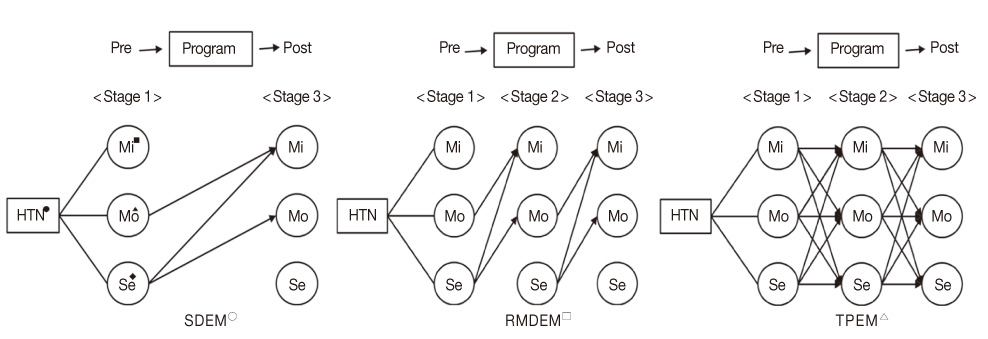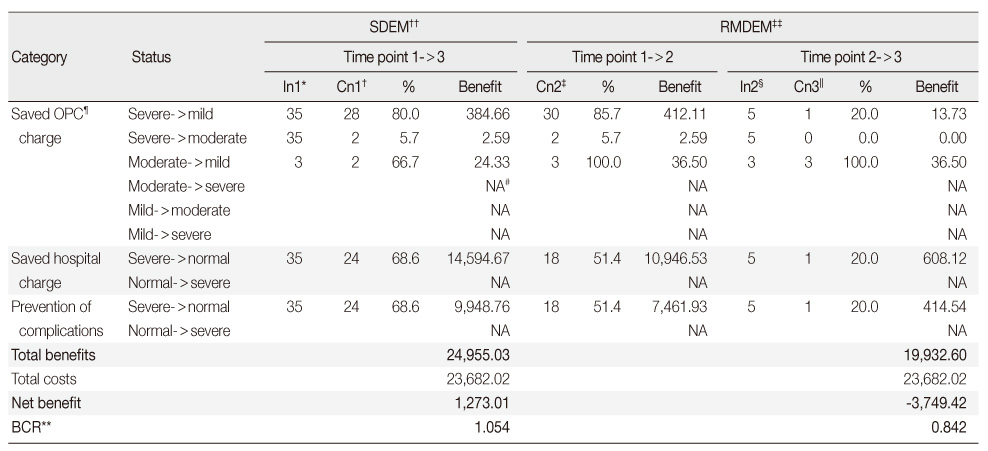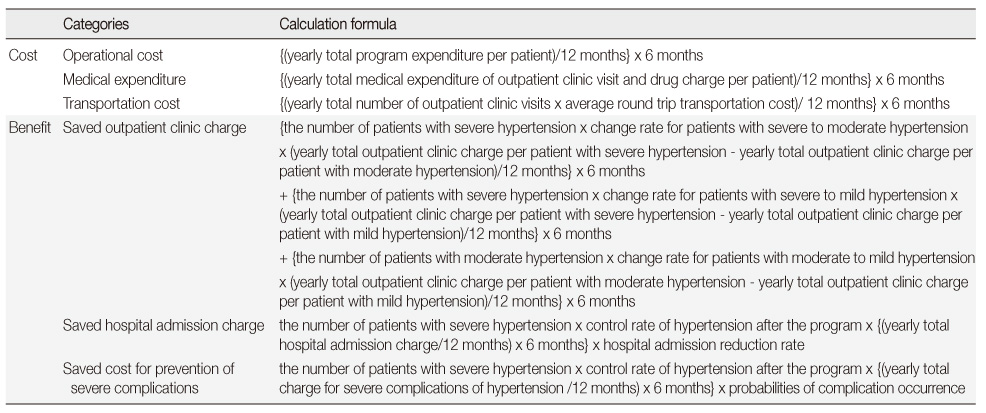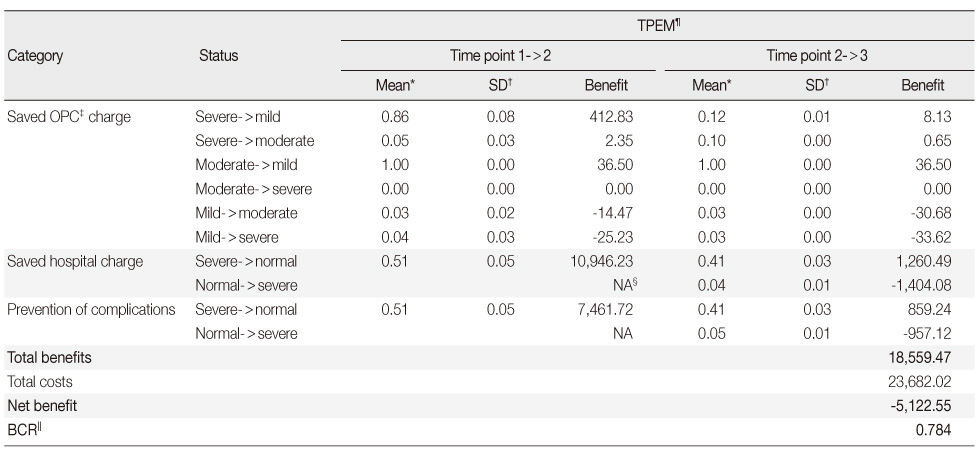Articles
- Page Path
- HOME > J Korean Acad Nurs > Volume 41(6); 2011 > Article
-
Original Article
- Comparison of Benefit Estimation Models in Cost-Benefit Analysis: A Case of Chronic Hypertension Management Programs
- Ji Young Lim, Mi Ja Kim, Chang Gi Park, Jung Yun Kim
-
Journal of Korean Academy of Nursing 2011;41(6):750-757.
DOI: https://doi.org/10.4040/jkan.2011.41.6.750
Published online: December 31, 2011
1Associate Professor, Department of Nursing, Inha University, Incheon, Korea.
2Professor, College of Nursing, University of Illinois at Chicago, Chicago, U.S.A.
3Senior Health Economist, College of Nursing, University of Illinois at Chicago, Chicago, U.S.A.
4Team Manager, Women's Policy Division, Incheon Metropolitan City Hall, Incheon, Korea.
- Address reprint requests to: Lim, Ji Young. Department of Nursing, Inha University, 253 Younghyun-dong, Nam-gu, Incheon 402-751, Korea. Tel: +82-32-860-8210, Fax: +82-32-874-5880, lim20712@inha.ac.kr
© 2011 Korean Society of Nursing Science
Abstract
-
Purpose
- Cost-benefit analysis is one of the most commonly used economic evaluation methods, which helps to inform the economic value of a program to decision makers. However, the selection of a correct benefit estimation method remains critical for accurate cost-benefit analysis. This paper compared benefit estimations among three different benefit estimation models.
-
Methods
- Data from community-based chronic hypertension management programs in a city in South Korea were used. Three different benefit estimation methods were compared. The first was a standard deterministic estimation model; second, a repeated-measures deterministic estimation model; and third, a transitional probability estimation model.
-
Results
- The estimated net benefit of the three different methods were $1,273.01, $-3,749.42, and $-5,122.55 respectively.
-
Conclusion
- The transitional probability estimation model showed the most correct and realistic benefit estimation, as it traced possible paths of changing status between time points and it accounted for both positive and negative benefits.
INTRODUCTION
METHODS
1) Community-based chronic hypertension management program
2) Three benefit estimation models
3) Cost and benefit measurement
RESULTS
DISCUSSION
CONCLUSION
- 1. Ahmed F, Elbasha EE, Thompson BL, Harris JR, Sneller V. Cost-benefit analysis of a new HEDIS performance measure for pneumococcal vaccination. Medical Decision Making. 2002;22(5):S58–S66. doi: 10.1177/027298902237711.PubMed
- 2. Ahn YO. The strategy of enhancing effectiveness of health examination. 1995;Seoul, National Health Insurance Corporation.
- 3. Alcocer L, Cueto L. Hypertension, a health economics perspective. Therapeutic Advances in Cardiovascular Disease. 2008;2:147–155. doi: 10.1177/1753944708090572.ArticlePubMedPDF
- 4. Chin MH, Zhang JX, Rathouz PJ. Transitions in health status in older patients with heart failure. Southern Medical Journal. 2003;96:1096–1106.ArticlePubMed
- 5. Diehr P, Patrick DL. Probabilities of transition among health states for older adults. Quality of Life Research. 2001;10:431–442.ArticlePubMedPDF
- 6. Korea Centers for Disease Control & Prevention. Community-based hypertension and diabetes management model development for improving adherence and compliance. 2007;05;Seoul, Author.
- 7. Lim J. The cost-benefit analysis of newly married couple health care program. 2008;Daejeon, Chungnam National University. Unpublished doctoral dissertation.
- 8. Lim JY, Im JN, Kim IA, Ko S. An evaluation of effects on hypertension and diabetes mellitus management of a community-based nursing care center using cost-benefit analysis. Journal of Korean Academy of Nursing Administration. 2010;16:295–305.Article
- 9. Newhouse RP. De we know how much the evidence-based intervention cost? The Journal of Nursing Administration. 2010;40:296–299. doi: 10.1097/NNA.0b013e3181e93760.PubMed
- 10. Pappas SH. The cost of nurse-sensitive adverse events. The Journal of Nursing Administration. 2008;38:230–236. doi: 10.1097/01.NNA.0000312770.19481.ce.ArticlePubMed
- 11. Peng R, Ling L, He Q. Self-rated health status transition and long-term care need. Health Policy. 2010;97:259–266. doi: 10.1016/j.healthpol.2010.05.009.ArticlePubMed
- 12. Romo R, Gifford L. A cost-benefit analysis of music therapy in a home hospice. Nursing Economics. 2007;25:353–358.PubMed
- 13. Stephens S. Hospital-based palliative care: Cost-effective care for patients with advanced disease. The Journal of Nursing Administration. 2008;38:143–145. doi: 10.1097/01.NNA.0000310724.20419.12.PubMed
- 14. Stevens B, Guerriere D, McKeever P, Croxford R, Miller KL, Watson-MacDonell J, et al. Economics of home vs. hospital breastfeeding support for newborns. Journal of Advanced Nursing. 2006;53:233–243.ArticlePubMed
- 15. Yim ES. Cost-benefit analysis of the case management for the elderly patients with hypertension. 2008;Seoul, Yonsei University. Unpublished doctoral dissertation.
REFERENCES


*Initial number of patients at the first time point; †Changed number of patients at third time point from first time point; ‡Changed number of patients at the second time point from first time point; §Initial number of patients at the second time point; ∥Changed number of patients at the third time point from second time point; ¶Outpatient clinic; #Not applicable; **Benefit-cost ratio; ††Standard deterministic estimation model; ‡‡Repeated-measures deterministic estimation model.
Figure & Data
REFERENCES
Citations

- Systematic Review of the Effectiveness of Community Intervention and Health Promotion Programs for the Prevention of Non-Communicable Diseases in Japan and Other East and Southeast Asian Countries
Akihiro Hirashiki, Atsuya Shimizu, Kenichiro Nomoto, Manabu Kokubo, Noriyuki Suzuki, Hidenori Arai
Circulation Reports.2022; 4(4): 149. CrossRef - A Systematic Review of Economic Evidence on Community Hypertension Interventions
Donglan Zhang, Guijing Wang, Heesoo Joo
American Journal of Preventive Medicine.2017; 53(6): S121. CrossRef

Figure 1
Costs and Benefits Calculation Formulas
Benefits and BCR of SDEM and RMDEM Models
*Initial number of patients at the first time point; †Changed number of patients at third time point from first time point; ‡Changed number of patients at the second time point from first time point; §Initial number of patients at the second time point; ∥Changed number of patients at the third time point from second time point; ¶Outpatient clinic; #Not applicable; **Benefit-cost ratio; ††Standard deterministic estimation model; ‡‡Repeated-measures deterministic estimation model.
Benefits and BCR of TPEM Model
*Average mean of transitional probabilities; †Standard Deviation of transitional probabilities; ‡Outpatient clinic; §Not applicable; ∥Benefit-cost ratio; ¶Transitional probability estimation model.
*Initial number of patients at the first time point; †Changed number of patients at third time point from first time point; ‡Changed number of patients at the second time point from first time point; §Initial number of patients at the second time point; ∥Changed number of patients at the third time point from second time point; ¶Outpatient clinic; #Not applicable; **Benefit-cost ratio; ††Standard deterministic estimation model; ‡‡Repeated-measures deterministic estimation model.
*Average mean of transitional probabilities; †Standard Deviation of transitional probabilities; ‡Outpatient clinic; §Not applicable; ∥Benefit-cost ratio; ¶Transitional probability estimation model.
 KSNS
KSNS
 E-SUBMISSION
E-SUBMISSION


 Cite
Cite

